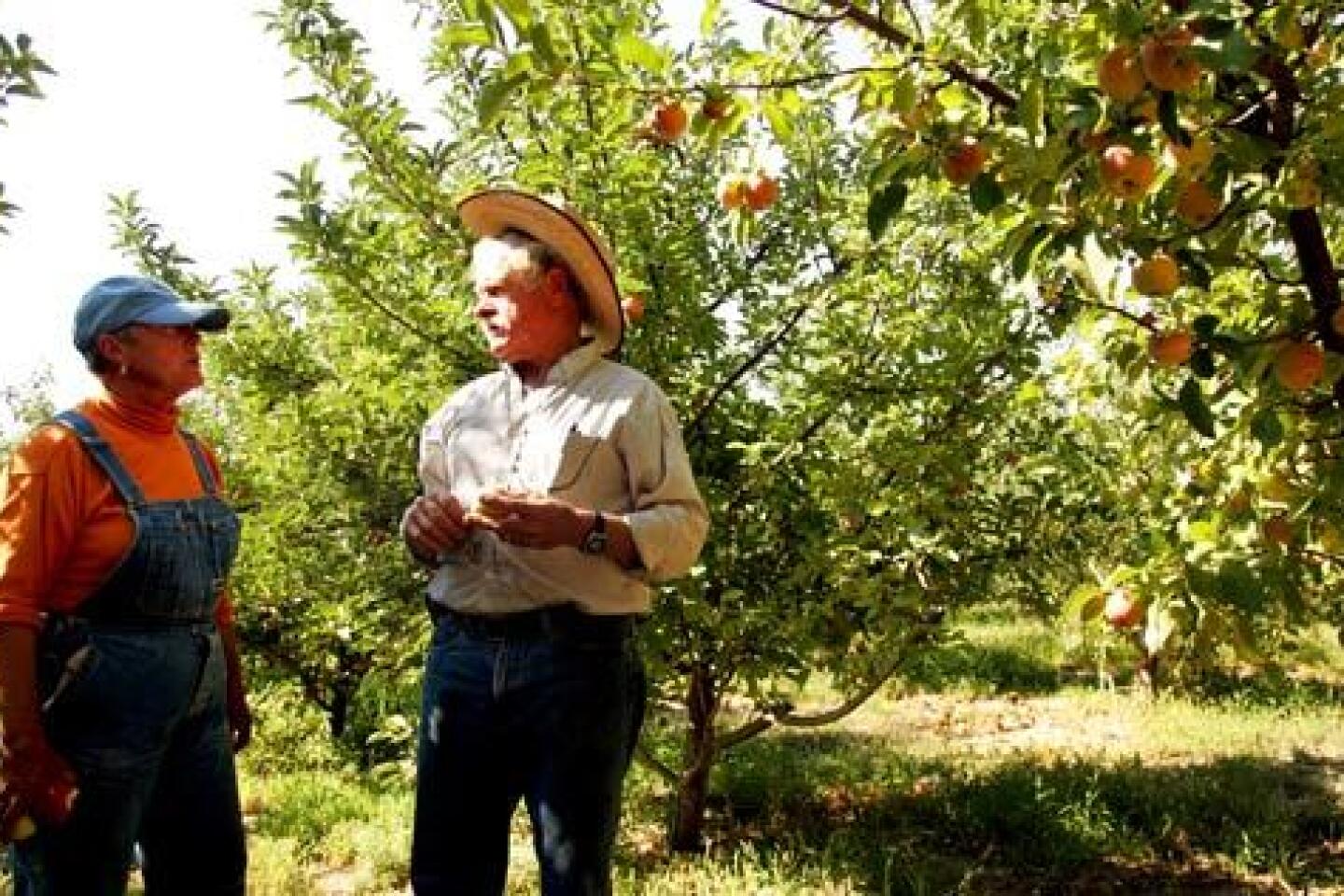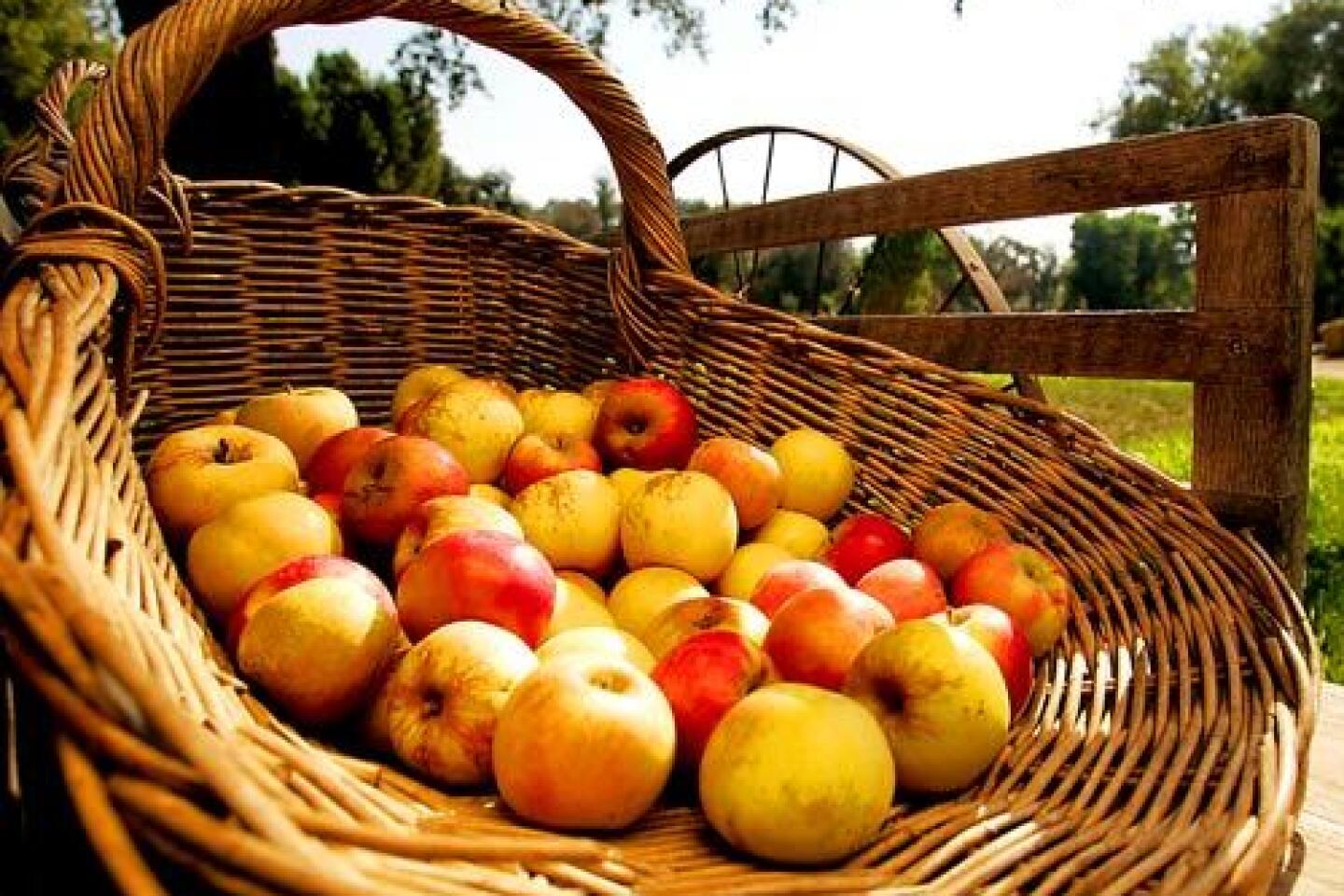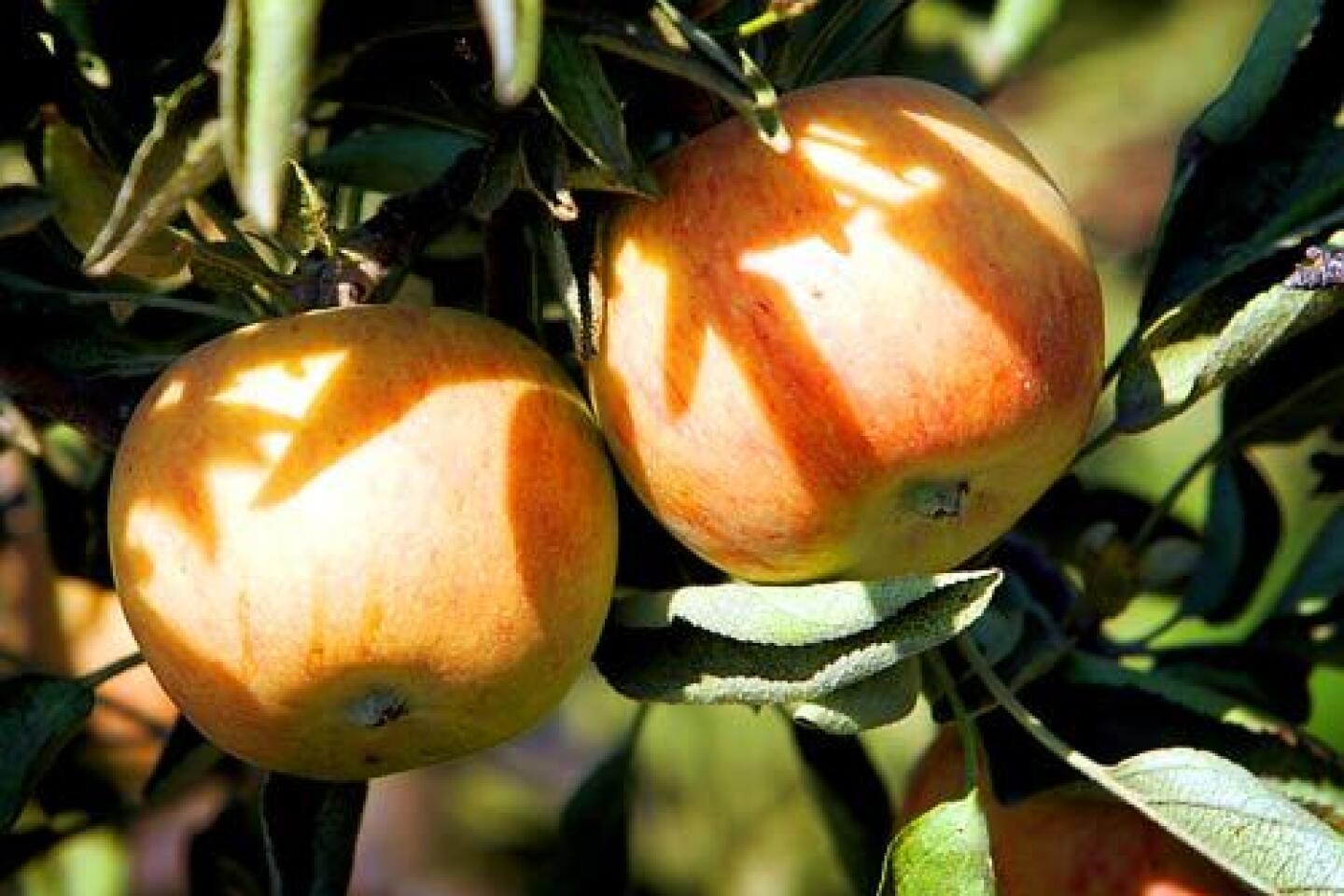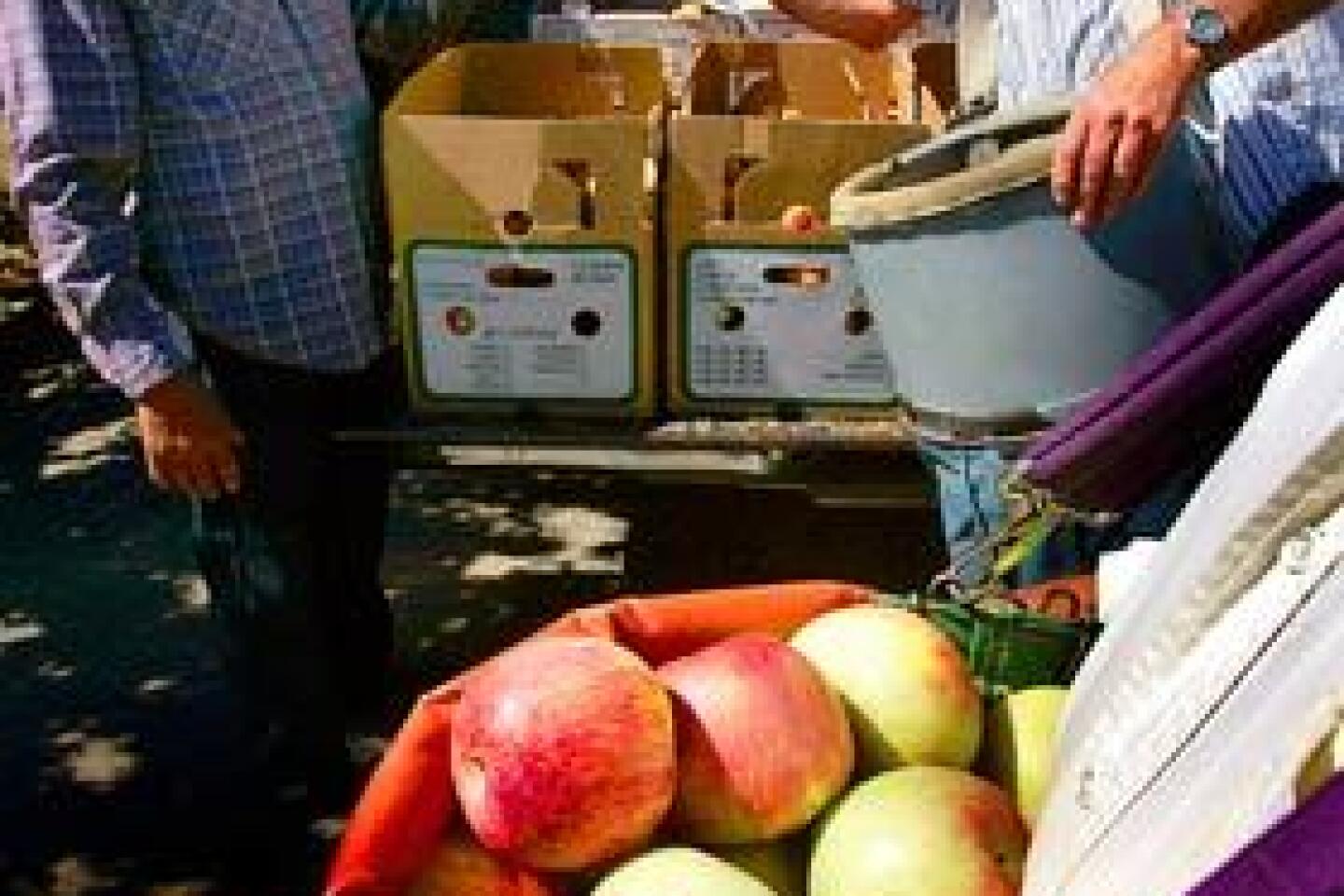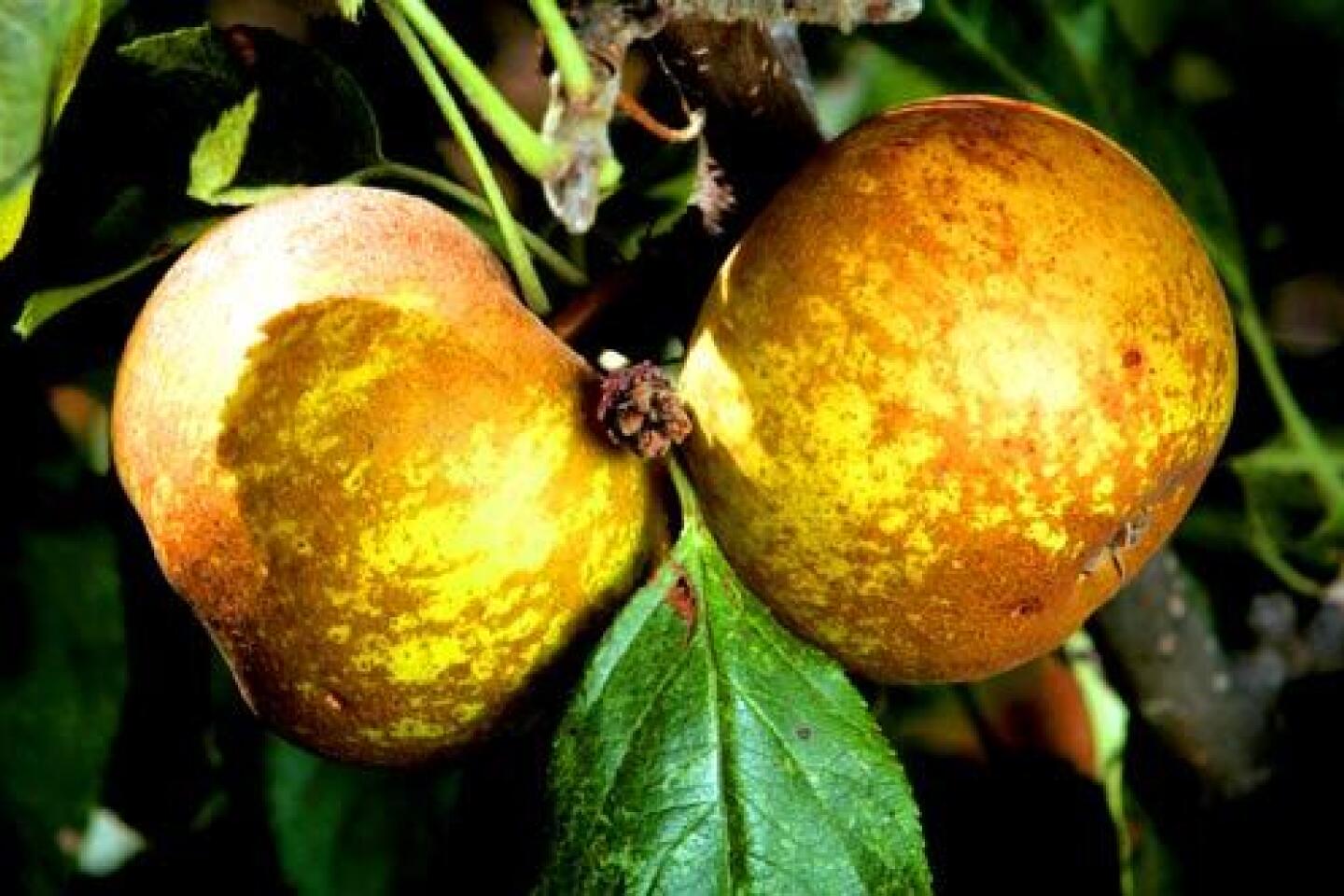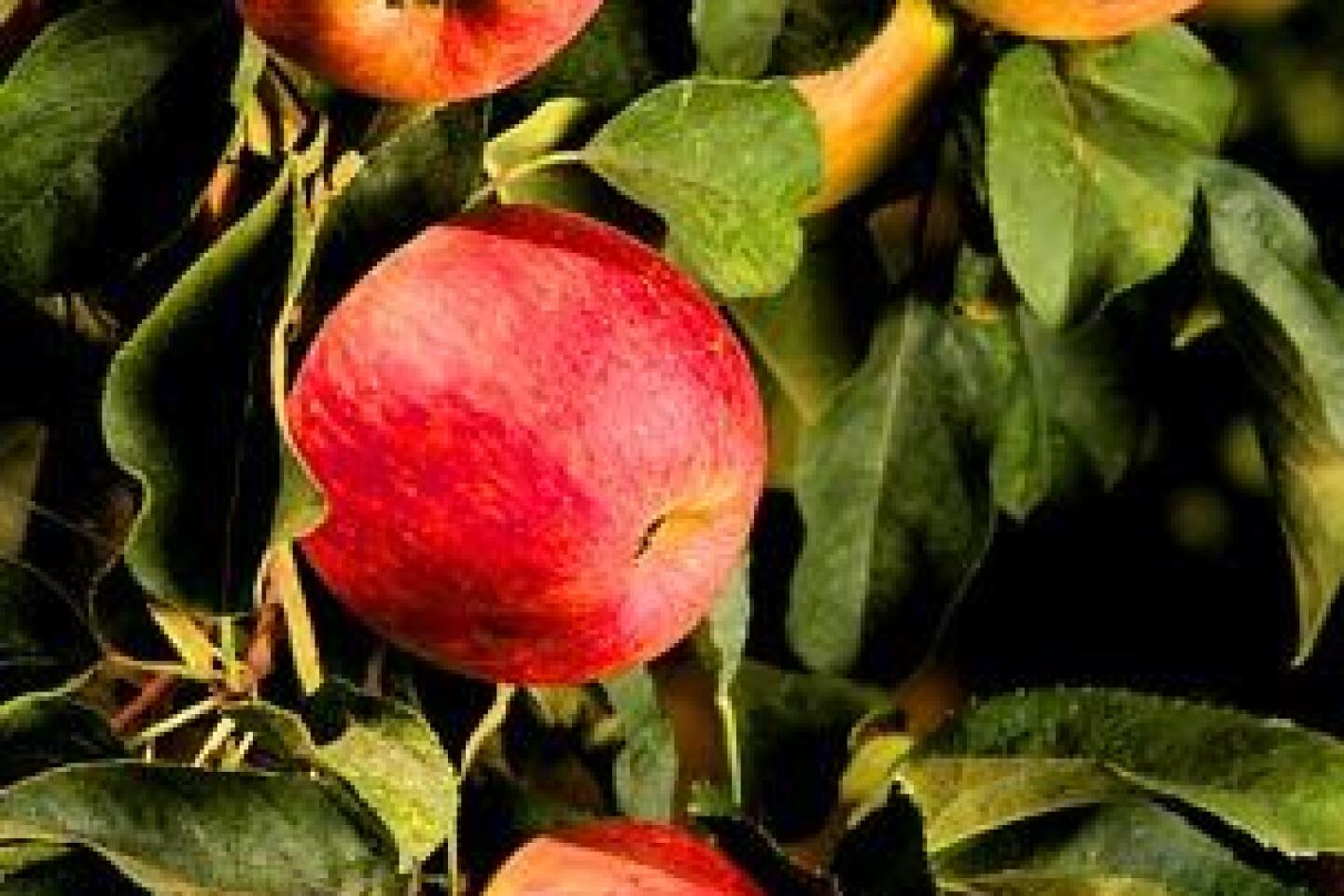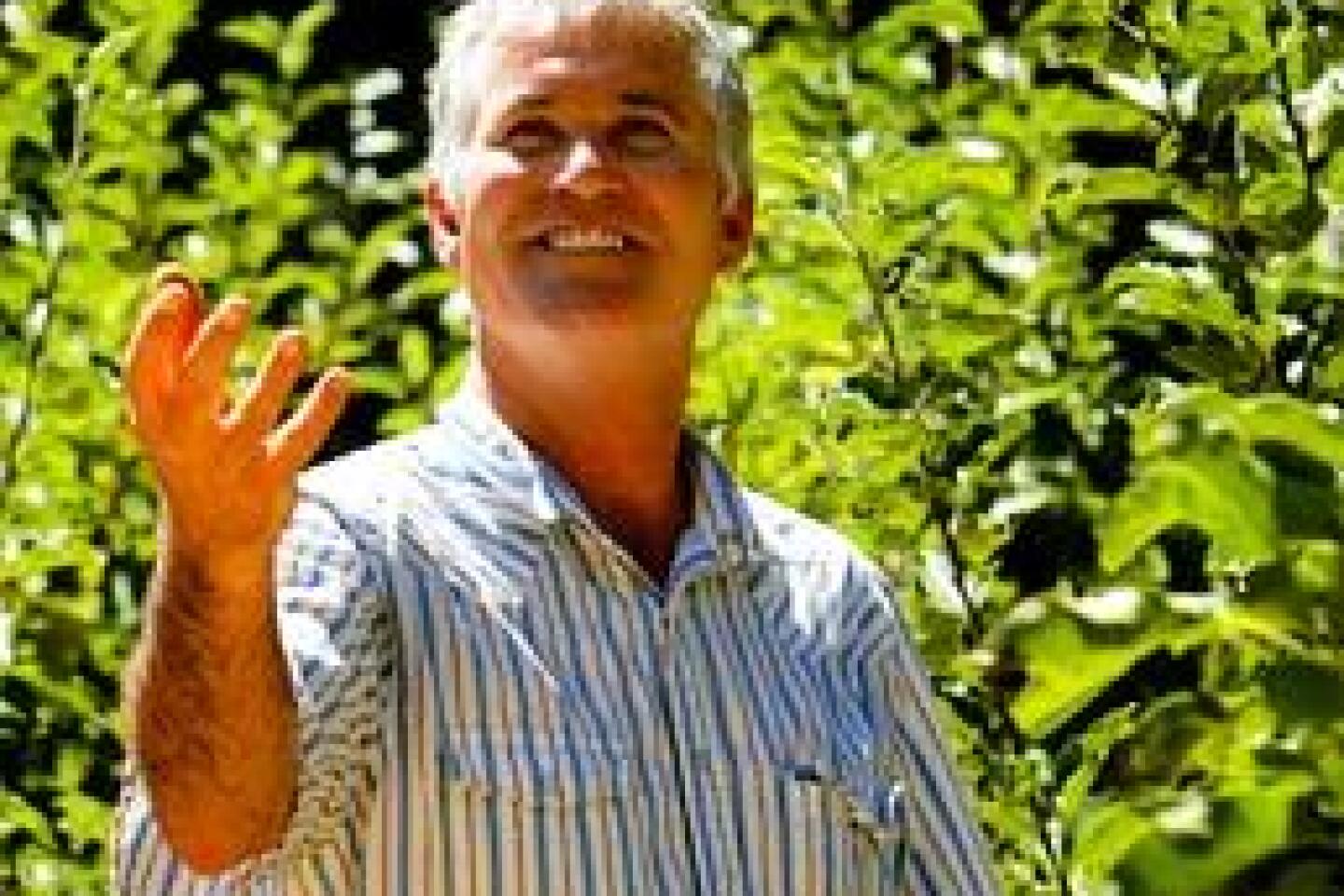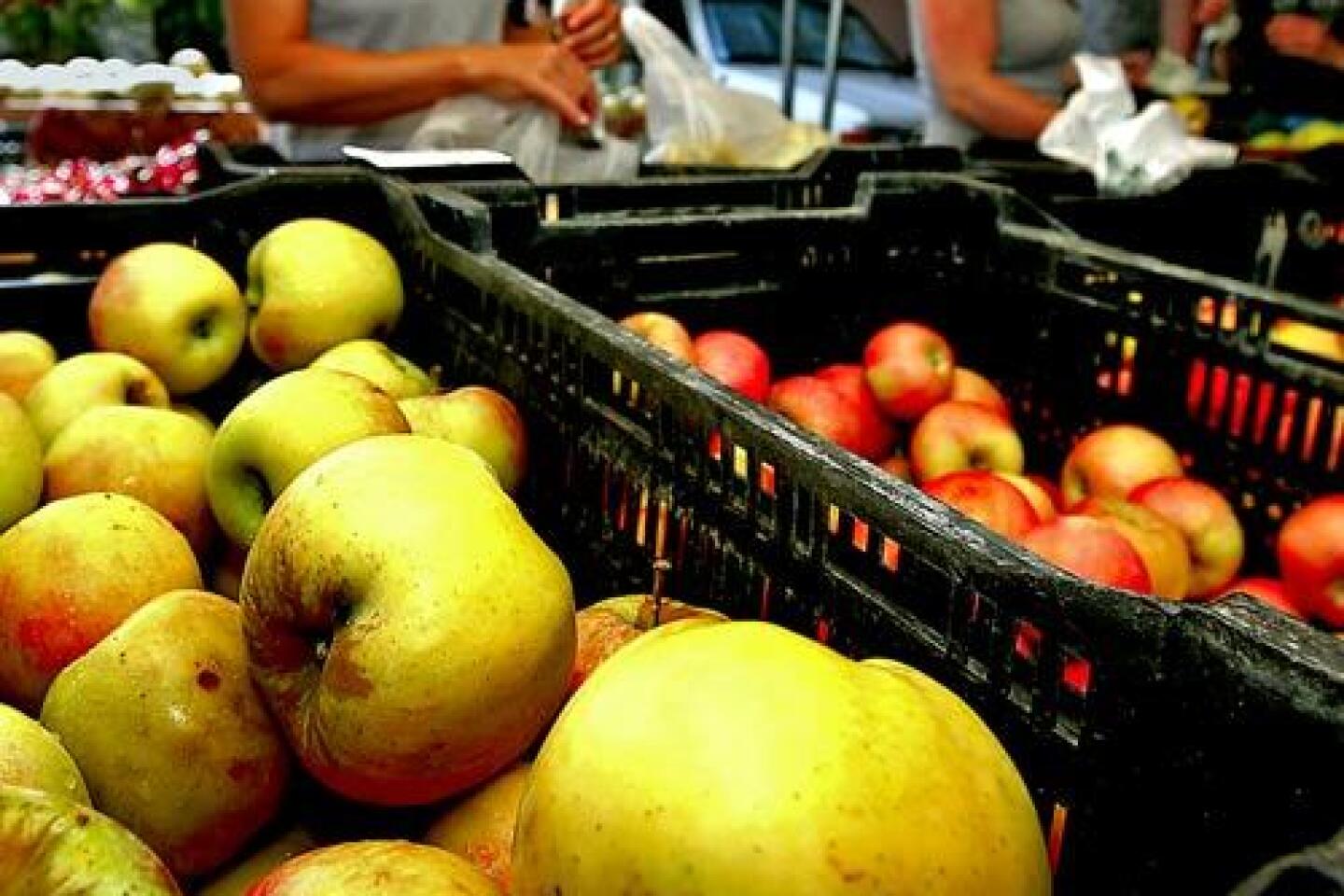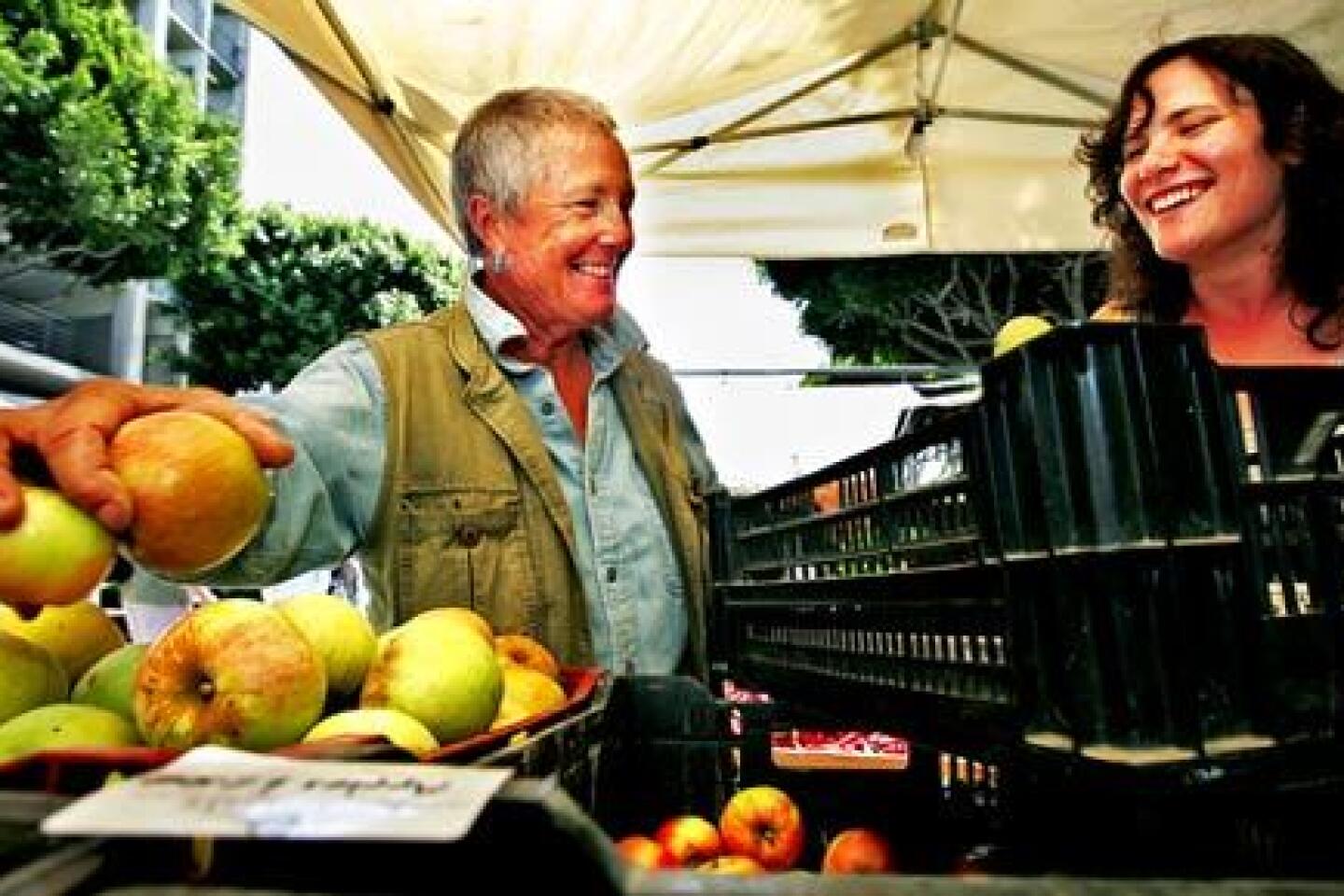At long last, heirloom apples
- Share via
SAN LUIS OBISPO — WATCH the faces of the shoppers as they paw through the bins of apples at the See Canyon or Windrose Farm stands at the Santa Monica Farmers Market. The spicy, tart perfume rises up as happy hands sort fruit. Depending on the season, there might be Bellflowers, Esopus Spitzenbergs, White Winter Pearmains, Smokehouses and Arkansas Blacks. Muttered like an incantation, these are names that set apple lovers’ hearts aflutter.
Apples are plentiful at Southern California farmers markets. Every fall there’s a big crop of Fujis and Galas, and certainly, these can be really good apples. But stop by these two stands and you’ll find something extraordinary -- apples with history. Some of these varieties have been available at Southern California farmers markets before, but this year, thanks to the work of a few enterprising farmers, there are more than ever.
These old apples can have a powerful pull. Bill Spencer of Windrose Farm likes to tell about the first year he and his wife, Barbara, brought their old apples to market. “There was an old woman from Germany or somewhere and the first time she tasted a Belle de Boskoop [an old variety from the Netherlands], she just broke down,” he says. “Tears were just streaming down her face. It was home and she hadn’t tasted it in 40 years.”
Though both farmers also grow new apples, these old varieties offer a range of flavors and textures that you can’t find anyplace else, and that demand exploring.
“The Fuji is a very good beginner’s apple,” says Mike Cirone of See Canyon. “But the Spitzenberg is for more sophisticated palates. And then there are apples like the Arkansas Black that will only appeal to certain people.
“But one thing I’ve noticed at the Santa Monica market is that customers who have been buying from us for years gradually drift into the older varieties.”
That is true whether you’re eating the apples out of hand, savoring their perfume and spice, or baking them to use in cakes, pies and ice cream.
In truth, it seems these old apples are as beguiling to the farmers who grow them as they are to the people who buy them.
Daisy Dell Ranch is about halfway up See Canyon, just outside of San Luis Obispo. The canyon is steep on both sides and the orchard is no more than a quarter-mile wide -- just about all the flat land available. Here, graceful, tall old trees are mixed in with short, bushy new ones, grown on dwarfing rootstock for easier working.
Here’s the Bellflower, a towering tree that was already bearing fruit in 1916 when the ranch was bought by the father of the current owners, three siblings now in their 90s. The variety dates back at least to 1817 and is probably related to the French Belle-Fleur apple that goes back much further. Here’s White Winter Pearmain, an English apple that dates to at least the 1200s. And here’s an Arkansas Black, which dates from 1870.
Less than 50 miles away, in the sun-seared hill country just east of Paso Robles, Windrose’s Bill Spencer farms venerable varieties as well. Here’s an Esopus Spitzenberg (1790): “Thomas Jefferson’s favorite apple,” he says. And here’s Calville Blanc (1598), Sierra Beauty (1890s), Smokehouse (1837) and Blacktwig (1868).
But just when you think you’ve stumbled into yet another apple antiquarian reverie, Spencer pulls you up short. Scattered among all of those old-timers are half a dozen modern apples, including Fuji, Gala, Anna and Mutsu, the last being one of his favorites.
“It’s got such great complexity,” he says. “So what am I supposed to do? Not grow a great apple because it’s new?”
It’s the same story in See Canyon. In fact, one of Cirone’s favorite apples is a Red Delicious, for goodness’ sake (though probably not like any you’ve ever had).
What’s going on here? Modern apple farming in California, that’s what.
At Daisy Dell Ranch and Windrose Farm, apples from California’s past and present are being knit together in the hopes that they add up to a real future.
Red, but not so deliciousTHE latter decades of the 20th century were extremely hard on American apple growers, and it’s not too strong to say that the industry was near collapse. One agricultural economist estimated that growers of Red Delicious lost money on every harvest in the 1990s. The Red Delicious had become a kind of poster child for what is wrong with modern agriculture.
Over the years, as it was bred to have darker and redder skin, few noticed until it was too late that the Red Delicious peel was also getting thicker and more bitter.
In California, at the far southern extreme of the fruit’s growing range, the situation has been worse. Apple acreage in the state has been cut in half in the last 20 years.
For Cirone and the Spencers, it’s selling at farmers markets, where they earn a greater percentage of the selling price, and offering apples that others can’t -- or won’t -- grow that gives them their edge.
When Cirone started farming apples in 1984, it was obvious, he says, that change was necessary.
“We just couldn’t compete on Golden Delicious, Red Delicious and Pippin,” Cirone says. “We started going with Galas and Fujis. And then at farmers markets, I saw that people were starting to get into some of the weird stuff: Bellflowers, Spitzenbergs and all. People were rediscovering apples. Between them, we just sold a load of fruit. What we ended up with is a real mix of old and new apples.”
On the roughly 30 acres that Cirone farms on assorted plots of leased land in See Canyon, the estimated 80 apple varieties range from cutting-edge modern to those that were popular at the start of the 20th century, when the area was an important apple-growing region.
“We’ve got two kinds of buyers,” Cirone says. “We’ve got a certain group who migrated to California and remember going to apple orchards in Connecticut and Massachusetts. They prefer tart apples. Most everyone else prefers sweet apples. As much as I try to ram them into the old varieties, when Fujis come in, my customers go crazy.”
Finding the right balanceIT’S the same at Windrose Farm. The Spencers’ 6-acre apple orchard, which stretches dark green across the base of sere brown hills, includes 45 varieties -- from the thoroughly modern Braeburn to the 16th century Calville Blanc.
Even today, Cirone’s orchards are in a state of flux as he seeks the right balance of varieties and the best examples for the growing area.
In one orchard he points out several old Red Gold trees that are being grafted over to other varieties, including Honeycrisp.
“The Red Gold just doesn’t cut it anymore,” Cirone says. “Sometimes old apples are just old apples. You can hold on to something for too long. You have to be a realist, and these just aren’t that good.”
Still, there are varieties that are sacrosanct. “When we started pulling out a lot of the old trees, I couldn’t let go of the Bellflower,” he says. “When it’s grown right, it’s probably my favorite apple. It’s so great. I just said to myself, ‘If it gets to the point I have to pull out the Bellflowers, I’d just rather not farm anymore.’ ”
Rather than inheriting old apple trees, the Spencers went out and bought them new. They were at a farm conference in 1994, Bill Spencer says, and on the drive home, Barbara told him she had good news and bad news.
“The bad news was that she had just bought 1,200 apple trees,” he says. “The good news was that I had two years to get ready for them.”
Enchanted by a panel discussion featuring modern-day Johnny Appleseed Terry Harrison, then of Sonoma Antique Apple Nursery, she had taken a major plunge.
“Farming is all about trusting your gut,” Bill Spencer says. “And since when you get right down to it, it’s Barbara’s farm, it’s Barbara’s gut.”
Barbara agrees. “That’s how little premeditation and business plan there was,” she says. “I knew we had all this cold [weather], so I figured it should work; but mainly, I just like apples.
“And I was sure the weird old varieties were right because I’d already been through the whole heirloom tomato thing. What works for one crop should work for them all.”
A weather anomalyTHEORETICALLY, the climate at Windrose Farm should be way too warm to grow apples successfully, and there is little history of apple farming in the area.
What saves it is an accident of geology. The farm is almost entirely circled by an old stream bed, which results in a kind of depression where the cold air settles.
“This place is just a miracle,” Bill says. “We got down to 6 degrees twice this winter. We easily exceed the requirements for chill hours. Let me tell you, it can get bloody cold.”
The trees respond. Bill says they pick 80 to 120 pounds of fruit per tree. And they’ve got 600 more trees coming in December to fill out the orchard’s remaining 3 acres.
Going strictly by the map, See Canyon hardly looks like apple country either. Only a massive ridge separates the oak-studded slopes from the Pacific Ocean. But an apple industry has thrived there for more than a century. Until 20 years ago, it was even shipping apples on a commercial scale.
The secret to the canyon’s success is that tall ridge separating it from the ocean. It is low enough to allow maritime breezes to creep over (the canyon is often shrouded in fog), yet the ridge is high enough that at the peak of summer the canyon is shady through the worst heat of the day.
“It’s kind of amazing,” Cirone says. “See Canyon just keeps going through thick and thin with apples. All varieties seem to flourish here. Low-chill apples, high-chill apples; apples that are bred for the West and apples that came from New England and apples that came from the South Atlantic states.”
Surprisingly, one of Cirone’s prize apples is the much-derided Red Delicious. But not the one you’re thinking of. Long before that variety became the blood-red whipping boy of the apple world, it was a sweet-tart pleasure, and its peel was pale.
Cirone still has a few of those trees. He prefers to call them “Hawkeyes” -- in deference to their home state of Iowa -- and because what apple lovers in their right mind would buy something called Red Delicious these days?
Those apples have been in See Canyon since soon after the variety was introduced, just before the turn of the 20th century. And Cirone says that as long as he’s farming, they’ll continue to have a home.
“These are the originals,” he says. “This is the See Canyon apple. This is what put See Canyon on the map and I’ll always grow them because even with all of these new varieties, it’s important for people to remember that.”
More to Read
Sign up for The Wild
We’ll help you find the best places to hike, bike and run, as well as the perfect silent spots for meditation and yoga.
You may occasionally receive promotional content from the Los Angeles Times.
